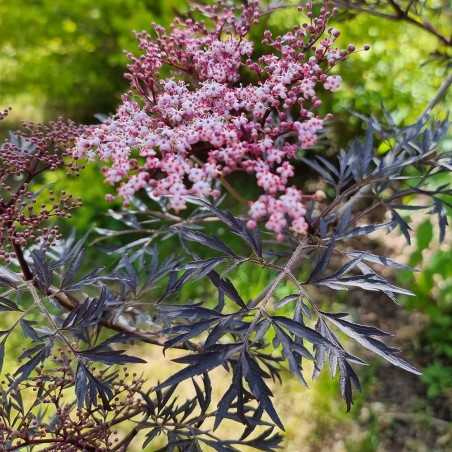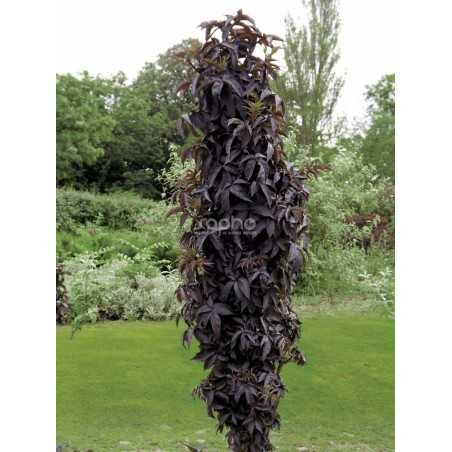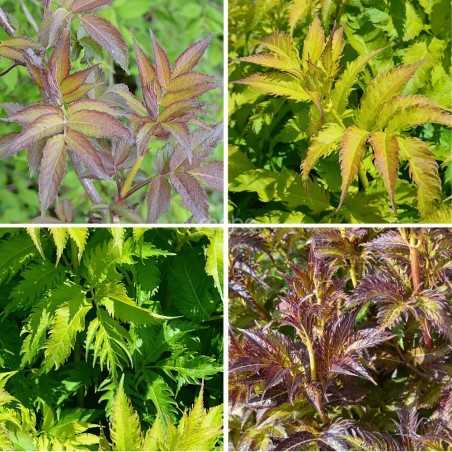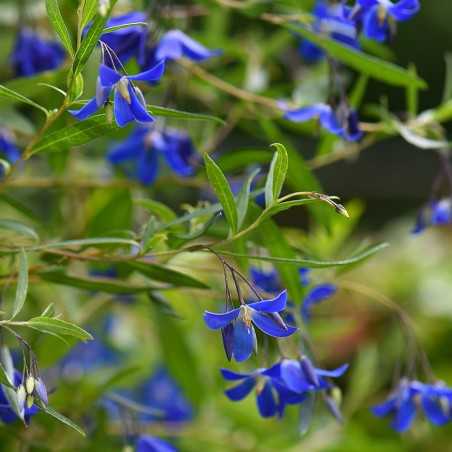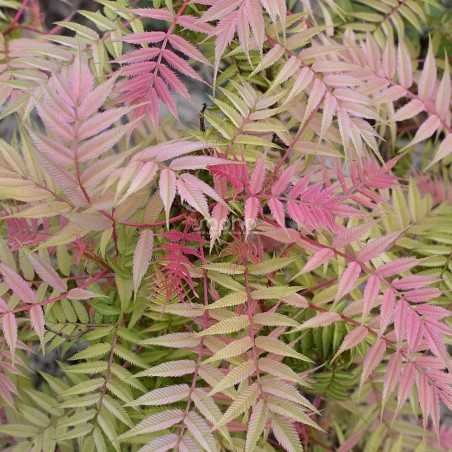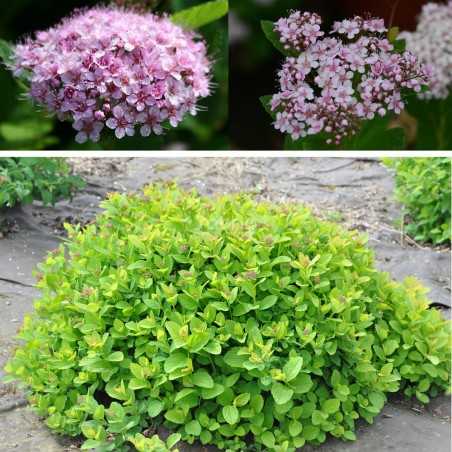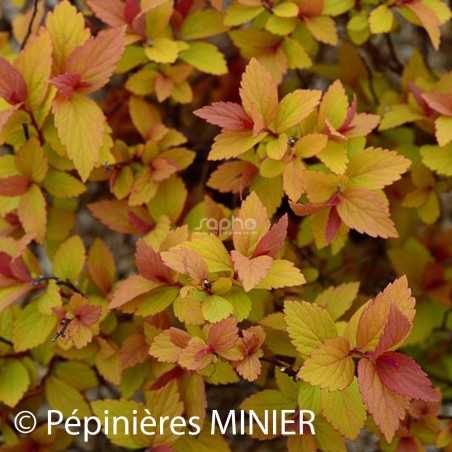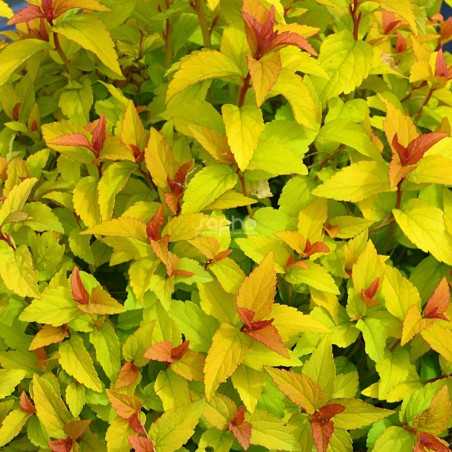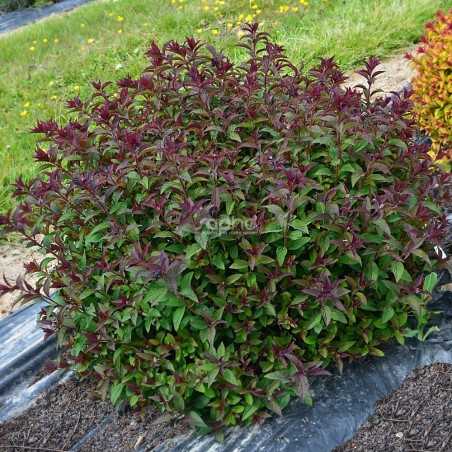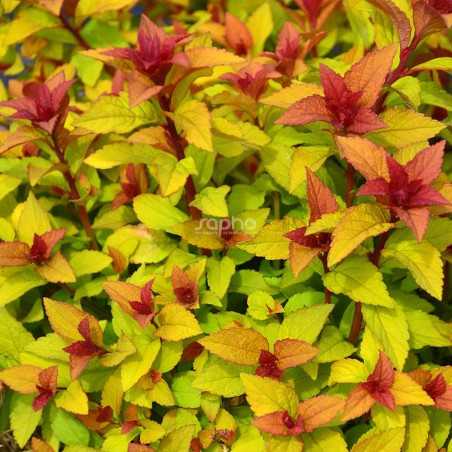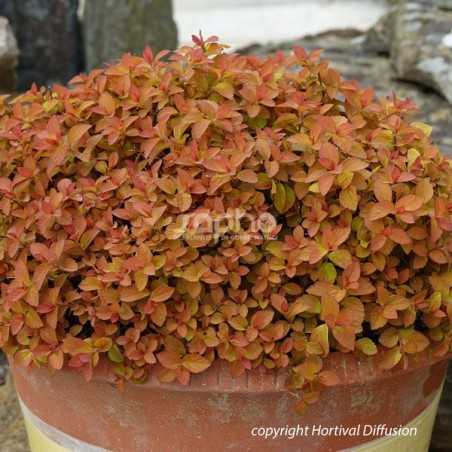Purple and lacinated, a very decorative elderThis elder is very elegant thanks to its big, deep purple, nearly black, finely dissected leaves. The young shoots are green. The shrub tolerates half shade, but planting it in full sun, emphasizes the beautiful colour of the foliage. Its growth is medium.In June, BLACK LACE is covered in flat, pink buds, getting paler at the opening stage to become a creamy white. The contrast to the dark foliage is remarkable.At the end of summer, the dark purple then black berries are appreciated by the birds.Its purple and lacinated foliage, its abundant flowers and berries make it an decor for the garden. BLACK LACE should be planted individually or in free growing shrub-hedges, together with evergreens, for example.
Filter By
Foliage
Position
Categories
Menu
All our varieties
Dark purple elder with an upright and thick shape.BLACK TOWER has an interesting upright and naturally thick shape.Its young shoots are green. Then the large-sized foliage becomes deep purple brown, covering the plant from the base upwards.In June - July, from a very young age, nearly at every node, numerous quite small pink and white flowers open, contrasting with the foliage. Black fruit appear in the autumn.
A serenade of brilliant coloursThe compound and toothed leaves are at first purple brown as the buds burst, then turn bronze to golden yellow and end up light green. The shrub thus shows different shades simultaneously, giving it a shimmery effect. Plant in a sunny position to show off all these colours at their best. In the autumn the leaves turn purple again.From May - June the small creamy white inflorescences stand out harmoniously from the purple, yellow and green foliage. They are followed by black berries at the end of summer and in autumn.The shape of the shrub is erect and well branched.Among others for the decorative effect of its foliage, SERENADE is best used in beds and free standing hedgerows.
An unusual climber with multiple, intensely blue bell-like flowersSollya heterophylla is an attractive and abundant climber for gardens where the climate is mild. It flowers freely from June to September. Its blue bell-like flowers spread from the junction with its leaves. This new variety, ULTRA BLUE, produces flowers that are larger and of a deeper, more luminous blue than the typical variety. Its habit is also better branched. Its twigs and leaves are fine but dense. The whole gives the impression of a well-developed climbing shrub from which emerge numerous tiny bells of blue.It's essentially a woody plant with herbaceous vegetation. In open ground Sollya heterophylla ULTRA BLUE should be limited to sheltered gardens in mild, coastal or Mediterranean climates, since it has a low resistance to frost. Easy to cultivate, it has a good resistance to drought. Grown in a large pot, it will decorate a terrace or patio during the warm months and can be over-wintered under glass or in a veranda.
A novelty for the Sorbaria genus : foliage with long lasting colours, a growth that stays compact
Concerning the Sorbaria species, where novelties are rare, PINK HOPI® 'COUSORB05' has been chosen for its qualities, different from those of 'Sem'.The compound, serrated foliage is delicate, light and harmoniously layered. It is a remarkable plant, due to its young variegated shoots which are red, pink and cream, then veined with white. Bud burst is extremely precocious, starting in early March. The shoots withstand the cold (at least up to -3° C). The colourful period lasts a month longer than in the traditional varieties, the shrub shines until the end of Mai. Later, in the summer, the foliage turns green.The shape of PINK HOPI® has the additional advantage of staying compact and this selection produces less suckers. Its dense foliage makes it a good ground cover.The white flower panicles bloom in June - July.The shrub does not need any maintenance (neither treating nor pruning). It is very hardy.
The first Spirea betulifolia dressed in pinkThis Spirea has a very compact growth like a dense pillow and a ground cover. It has bright light green foliage. This is the first selection of the Betulifolia species whith coloured corymbs. It is generous in small light pink flowers during May-June; then, if it is cut back again after the first flowering, a second, somewhat lighter one follows at the end of summer.A beautiful innovation in the small shrubs, perfectly adapted in very cold regions.
Radiant foliage with evolving colours, an even and compact formLittle Flame® is a fine improvement on the variety 'Goldflame', being neater and more compact in growth, very solid and resistant to powdery mildew. It's particularly admired for its glossy leaves of changing colours. In spring, the tips of the young shoots are bronze-orange. The leaves become yellow, then a golden green throughout the summer, acquiring beautiful coppery-orange tints in autumn. Its carmine rose flowers appear in umbels in summer.
A young bright red foliage, golden-yellow in summer, with an intense growth of dark pink flowersIn spring, the foliage of Merlo® Gold has a remarkable intensity, mixing young firey-red shoots and small lemon-yellow leaves. In summer the foliage remains yellow. It has a naturally round and regular habit. In June Merlo® Gold is covered with a multitude of small dark red flowers. Removing the first faded corymbs will encourage a second flowering. Resistant to powdery mildew, this new spirea will mix wonderfully in beds with other shrubs or colourfully-leaved perennials.
Young bright purple foliage, followed by intense carmine pink flowersIn spring the young shoots, at first bright purple red, then becoming darker, make a contrast with the overall green foliage. The serrated and subtly veined leaf blades stay purple for quite a while before changing to dark green. In the autumn they turn bronze. This selection is not very sensitive to powdery mildew. In June the plant is covered in carmine pink flowers reaching up to 8 cm. Taking off the first wilted corymbs favours renewed flowering right into September.Its regular round bushy growth is easy on the eye and its moderate dimensions make it a shrub which lends itself to be either pot grown, be in the foreground of a flower bed or in a border.
A young orange-red foliage, greeny-yellow in summer, with an intense growth of dark pink flowers
In spring, Merlo® Star's foliage is remarkably intense, combining young orange-red shoots and little golden-yellow leaves. In summer the leaves turn a bright greeny-yellow. Its habit is very compact and round. In June, Merlo® Star is covered with a multitude of little dark pink flowers. Removing the first faded corymbs will help re-flowering. Resistant to powdery mildew, this new spirea will mix wonderfully in beds with other shrubs or colourfully-leaved perennials.
Seductive caramel-orange foliage growing in the form of an inviting cushionThe Spiraea japonica Zen'Spirit® Caramel is a small bush with a compact habit that forms dense, rounded cushions. This new variety is notable for its young caramel-orange foliage that persists for several weeks in spring before turning green. Pruning will encourage a repeat performance. In autumn the foliage develops beautiful red tints. Its flowering is typical of Japanese Spiraea: in summer the bouquets of flowers in purple-pink corymbs emerge above the foliage. Once well-established, it tolerates brief periods of drought and a little lime. Zen'Spirit® Caramel is an easy plant that requires limited attention. It grows to a limited height (40 to 60 cms). Its restrained development makes it ideal for rockeries, flowerbed borders, terraces, low hedges or tubs.
A delightful small cushion of golden yellow foliageThe Spiraea japonica Zen'Spirit® Gold is a shrub of limited development and highly compact habit. In spring, its foliage is a beautiful luminous gold that persists throughout the summer. Freely branching with a delicate wood, this Spiraea forms a dense and colourful, spreading cushion. The flowers are very discrete. It's a plant that's appreciated above all for its foliage and its decorative form adapted to small spaces, borders or pots.

